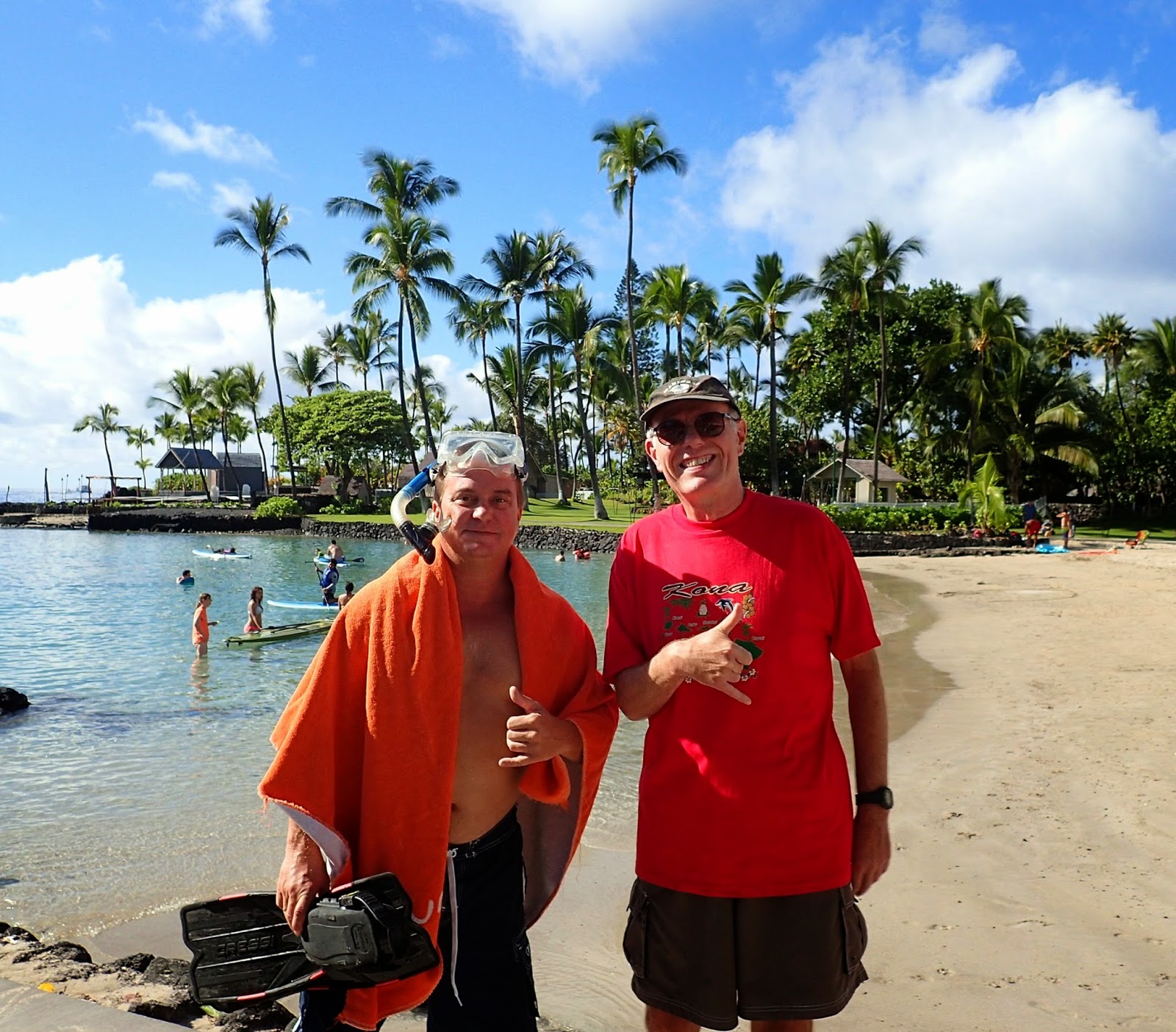 |
| The Author and Sir Galahad Set Out for the Holy Grail |
By arrangement, we met our friend Kyle at the pier at 10 AM. As a non-swimmer for a few more days, Sandra would stay ashore while Kyle and I carried on the Christmas tradition.
The water was cool and clear as we plunged into the Inner Harbour. This being Christmas, the beach in front of the King Kam Hotel (now a Marriot) was chock-a-block full. The throng was mostly tourists, sunning, swimming and paddle boarding, but there was a smattering of us locals, as well. Everyone was good natured as Kyle and I made our way out of the inner harbour, past the jetty, through the paddle boarders and into Kailua Bay. I'd like to say that the water in the bay was a lot warmer than the inner harbour, but, as Kenneth said on 30 Rock, "Every time I tell a lie, an angel in heaven
 |
| Christmas Wrasse January 30, 2011 Paul Allen's Reef |
Actually, the water temperature wasn't that bad as we reconnoitered in the middle of the inlet. I asked Kyle if he had seen a Christmas Wrasse as he swam along the shore. He chose this moment to reveal that he didn't actually know what a Christmas Wrasse looked like. Up to this point, I had thought of Kyle as a latter day Sir Galahad, he of the Siege Perilous, who would lead us to the Christmas Wrasse, the Holy Grail on this day of the nativity. While Kyle is extremely competent in the water, my quick description, "the one with the blue and red spots, was probably inadequate to surmount the taxonomic hurdle. The problem was further aggravated as said wrasse is no longer a common fish. If you don't know enough to look for a Christmas Wrasse, you probably won't even notice this fast moving fish.
 |
| Christmas Wrasse Dec 28, 2010 Kona Makai |
On the far shore of the bay, tucked into the coral we spotted a Zebra Moray.
I saw an eel on Christmas Day/ A Moray Eel that made me Squeal!
I saw an eel on Christmas Day / On Christmas Day in the morning.
Well. I no longer squeal at eels, so we swam around the corner, still looking for the wrasse with the red and blue spots. Out on Paul Allen's Reef proper, the water was clear and kinetic. This was acceptable, as the Christmas Wrasse, similar to the more uncommon Five Stripe and Surge Wrasses, really likes moving water. We swam along the edge, the bright sunlight sparkling in the surf, highlighting the Spotted Surgeons that love the splash. A school of mullets glimmered like tinsel in the swirling shallows.
Just over half way out I spotted a Christmas Wrasse! It was a big, beautiful adult swimming a few feet below me along the lava palisade. I looked up to call Kyle and when I looked down, the fish was gone. We searched for a couple minutes, but there is a lot of water out there on the PAR and he was no where to be seen.
I saw a Wrasse on Christmas Day!
A Christmas Wrasse swam up my (well, you get the idea.)
On Christmas Day in the Morning.
 |
| Porcupinefish Christmas Day 2014 |
I was sad that I had been unable to show the Christmas Wrasse to Kyle, but elated that the Good Lord had renewed our covenant for the coming year. On the way in, we had a fine close look at a Porcupinefish. And just outside the jetty we enjoyed a Zebra Moray hunting in about ten feet.
Sandra was waiting for us on shore, all dry and pretty. She was overjoyed by the news of the sighting; you can rest assured that the Redoubtable SKG knows a Christmas Wrasse when she sees one.
 |
| Don't Squeal for the Eel. He is a shy fellow of good will. |
On Christmas Eve, we went to a caroling service outside the oldest church in Hawaii on Alii drive opposite the palace. Noting that they were a man short, I nabbed a song booklet, slipped in and sang along. The last song we sang was O Little Town of Bethlehem. As the rest of the choir headed into the church, I sang my version of this classic to a non-existant audience. When I get up early in the morning, or sometimes at night, I look down on the twinkling lights of Kailua and sing these lyrics. This seems like the right time to share them with you.
O little town Kailuaville
How still we see thee rise
Upon thy reef in dreamless sleep
The Silent Fish swim by.
But in the dark depths shineth
The phosphorescent light.
The Sharks and Rays that rest by day
Swim here with us tonight.
 |
| Christmas Fish courtesy of Rene Umberger of Save the Fishes |
The keiki dreams of Sugarplums
The Ironman his run.
Praise God for Peace to all the Fish
From here to Kingdom Come.
Until we meet again, may the Dear Good Lord bless you and keep you. And may he watch over all the fishes that we hold so dear.
jeff

















































